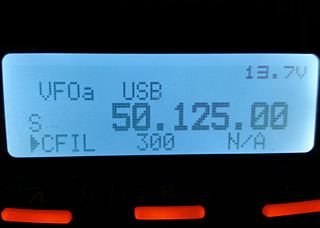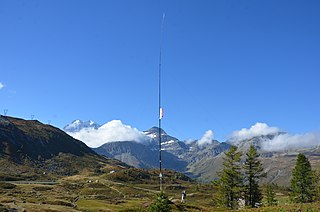Related Research Articles

Shortwave radio is radio transmission using radio frequencies in the shortwave bands (SW). There is no official definition of the band range, but it always includes all of the high frequency band (HF), which extends from 3 to 30 MHz ; above the medium frequency band (MF), to the bottom of the VHF band.

Very high frequency (VHF) is the ITU designation for the range of radio frequency electromagnetic waves from 30 to 300 megahertz (MHz), with corresponding wavelengths of ten meters to one meter. Frequencies immediately below VHF are denoted high frequency (HF), and the next higher frequencies are known as ultra high frequency (UHF).

Citizens band radio is a land mobile radio system, a system allowing short-distance one-to-many bidirectional voice communication among individuals, using two-way radios operating near 27 MHz in the high frequency or shortwave band. Citizens band is distinct from other personal radio service allocations such as FRS, GMRS, MURS, UHF CB and the Amateur Radio Service. In many countries, CB operation does not require a license and may be used for business or personal communications.

Ultra high frequency (UHF) is the ITU designation for radio frequencies in the range between 300 megahertz (MHz) and 3 gigahertz (GHz), also known as the decimetre band as the wavelengths range from one meter to one tenth of a meter. Radio waves with frequencies above the UHF band fall into the super-high frequency (SHF) or microwave frequency range. Lower frequency signals fall into the VHF or lower bands. UHF radio waves propagate mainly by line of sight; they are blocked by hills and large buildings although the transmission through building walls is strong enough for indoor reception. They are used for television broadcasting, cell phones, satellite communication including GPS, personal radio services including Wi-Fi and Bluetooth, walkie-talkies, cordless phones, satellite phones, and numerous other applications.

Medium frequency (MF) is the ITU designation for radio frequencies (RF) in the range of 300 kilohertz (kHz) to 3 megahertz (MHz). Part of this band is the medium wave (MW) AM broadcast band. The MF band is also known as the hectometer band as the wavelengths range from ten to one hectometers. Frequencies immediately below MF are denoted as low frequency (LF), while the first band of higher frequencies is known as high frequency (HF). MF is mostly used for AM radio broadcasting, navigational radio beacons, maritime ship-to-shore communication, and transoceanic air traffic control.

High frequency (HF) is the ITU designation for the range of radio frequency electromagnetic waves between 3 and 30 megahertz (MHz). It is also known as the decameter band or decameter wave as its wavelengths range from one to ten decameters. Frequencies immediately below HF are denoted medium frequency (MF), while the next band of higher frequencies is known as the very high frequency (VHF) band. The HF band is a major part of the shortwave band of frequencies, so communication at these frequencies is often called shortwave radio. Because radio waves in this band can be reflected back to Earth by the ionosphere layer in the atmosphere – a method known as "skip" or "skywave" propagation – these frequencies are suitable for long-distance communication across intercontinental distances and for mountainous terrains which prevent line-of-sight communications. The band is used by international shortwave broadcasting stations (3.95–25.82 MHz), aviation communication, government time stations, weather stations, amateur radio and citizens band services, among other uses.

Digital Radio Mondiale is a set of digital audio broadcasting technologies designed to work over the bands currently used for analogue radio broadcasting including AM broadcasting—particularly shortwave—and FM broadcasting. DRM is more spectrally efficient than AM and FM, allowing more stations, at higher quality, into a given amount of bandwidth, using xHE-AAC audio coding format. Various other MPEG-4 codecs and Opus are also compatible, but the standard now specifies xHE-AAC.
The radio spectrum is the part of the electromagnetic spectrum with frequencies from 3 Hz to 3,000 GHz (3 THz). Electromagnetic waves in this frequency range, called radio waves, are widely used in modern technology, particularly in telecommunication. To prevent interference between different users, the generation and transmission of radio waves is strictly regulated by national laws, coordinated by an international body, the International Telecommunication Union (ITU).

The 6-meter band is the lowest portion of the very high frequency (VHF) radio spectrum internationally allocated to amateur radio use. The term refers to the average signal wavelength of 6 meters.
160-meter band refers to the band of radio frequencies between 1.8 and 2 MHz, just above the medium wave broadcast band. For many decades the lowest radio frequency band allocated for use by amateur radio, before the adoption, at the beginning of the 21st century in most countries, of the 630- and 2200-meter bands. Amateur operators often refer to 160 meters as the Top Band It is also sometimes nicknamed the "Gentleman's Band" in contrast to the often-freewheeling activity in the 80-, 40- and 20-meter bands.
LowFER refers to experimental radio communication practiced by hobbyists on frequencies below 300 kHz, a part of the radio spectrum known as low frequency. The practitioners are known as "LowFERs".
The 80 meter or 3.5 MHz band is a span of radio frequencies allocated for amateur use, from 3.5–4.0 MHz in North and South America ; generally 3.5–3.8 MHz in Europe, Africa, and northern Asia (Region 1); and 3.5–3.9 MHz in south and east Asia and the eastern Pacific (Region 3). The upper portion of the band, which is usually used for phone (voice), is sometimes referred to as 75 meters; however, in Europe, "75 m" is used to name an overlapping shortwave broadcast band between 3.9–4.0 MHz used by a number of national radio services.

The 40-meter or 7-MHz band is an amateur radio frequency band, spanning 7.000-7.300 MHz in ITU Region 2, and 7.000-7.200 MHz in Regions 1 & 3. It is allocated to radio amateurs worldwide on a primary basis; however, only 7.000-7.200 MHz is exclusively allocated to amateur radio worldwide. Shortwave broadcasters and land mobile users also have primary allocations in some countries, and amateur stations must share the band with these users.
The 10-meter band is a portion of the shortwave radio spectrum internationally allocated to amateur radio and amateur satellite use on a primary basis. The band consists of frequencies stretching from 28.000 to 29.700 MHz.

The 60-meter band or 5 MHz band is a relatively new amateur radio allocation, first introduced in 2002, that was originally only available in a few countries, such as the United States, United Kingdom, Norway, Finland, Denmark, Ireland and Iceland. Over a number of years however, an increasing proportion of countries' telecommunications administrations – together with their government and military users – have permitted Amateur Radio operation in the 5 MHz area on a short or longer-term basis, ranging from discrete channels to a frequency band allocation.
Amateur radio frequency allocation is done by national telecommunication authorities. Globally, the International Telecommunication Union (ITU) oversees how much radio spectrum is set aside for amateur radio transmissions. Individual amateur stations are free to use any frequency within authorized frequency ranges; authorized bands may vary by the class of the station license.
The World Administrative Radio Conference (WARC) bands are three portions of the shortwave radio spectrum used by licensed and/or certified amateur radio operators. They consist of 30 meters (10.1–10.15 MHz), 17 meters (18.068–18.168 MHz), and 12 meters (24.89–24.99 MHz). They were named after the World Administrative Radio Conference, which in 1979 created a worldwide allocation of these bands for amateur use. The bands were opened for use in the early 1980s. Due to their relatively small bandwidth of 100 kHz or less, there is a gentlemen's agreement that the WARC bands may not be used for general contesting. This agreement has been codified in official recommendations, such as the IARU Region 1 HF Manager's Handbook, which states: "Contest activity shall not take place on the 5, 10, 18 and 24 MHz bands."
In the United States, the Citizens Band Radio Service (CBRS), commonly called citizens band radio, is one of several personal radio services defined under Title 47 of the Code of Federal Regulations, Part 95. It is intended to be a two-way voice communication service for use in personal and business activities of the general public, and has a reliable communications range of several miles, though the range is highly dependent on type of radio, antenna and propagation.

A personal radio service is any system that allows individual to operate radio transmitters and receivers for personal purposes with minimal or no special license or individual authorization. Personal radio services exist around the world and typically use light-weight walkie talkie portable radios. The power output, antenna size, and technical characteristics of the equipment are set by regulations in each country. Many regions have standardized personal radio service rules to allow travelers from one country to use their equipment in another country. Examples of standardized services include PMR446 and FM Citizens Band Radio (CB) in the EU and several other countries/regions. 26–27 MHz CB radio is the oldest personal radio service and is used in nearly every country worldwide, with many countries and regions copying the United States 40-channel frequency plan. In many countries, CB radio is less popular due to the availability of other personal radio services that offer shorter antennas and better protection from noise and interference.
The 8 meter band (40 MHz) is at present the lowest portion of the very high frequency (VHF) radio spectrum allocated to amateur radio use. The term refers to the average signal wavelength of 8 meters.
References
- ↑ "Short wave broadcast bands". MonitoringTimes.com. Retrieved 2010-11-19.
- ↑ Introduction on digital technology in the HFBC bands Accessed 2011-10-20. (Archived by WebCite at https://www.webcitation.org/62aCbliW6?url=http://www.itu.int/ITU-R/terrestrial/broadcast/hf/wrc-03/index.html Archived 2008-04-15 at the Wayback Machine
- ↑ http://stakeholders.ofcom.org.uk/binaries/consultations/cads_scheme/statement/statement.pdf [ bare URL PDF ]